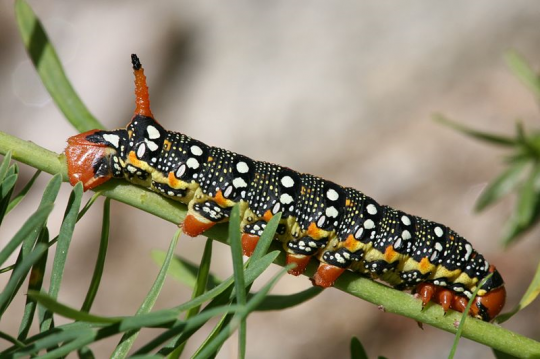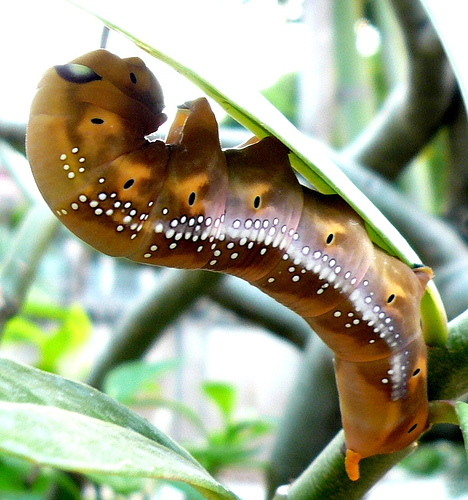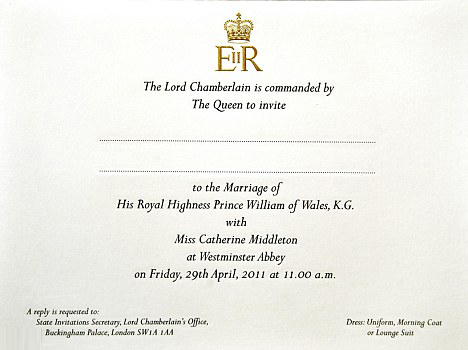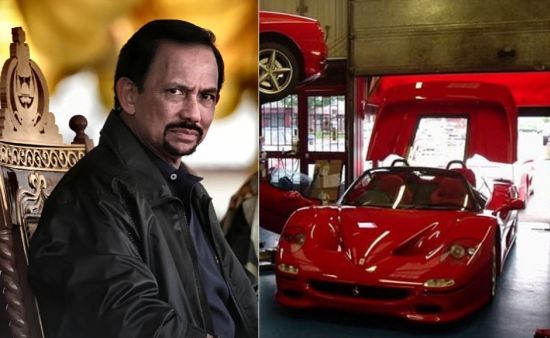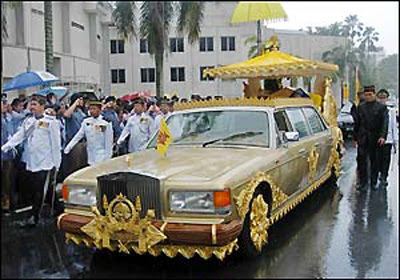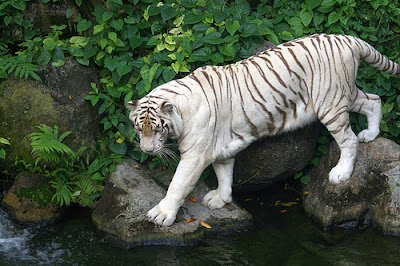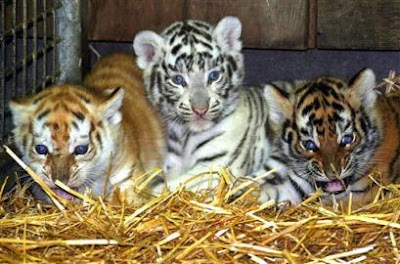↧
Piyush Vani - on Transparent Sheet with the help of Fabric Cone Liner
↧
Shri Atal Bihari Vajpayee’s “Meri Ekyavan Kavitayen” on Magic Sheet with the help of Wooden Pen
↧
↧
Happy Thanksgiving Day - A joyous family festival celebrated with lot of enthusiasm in US, Canada and several other countries
Thanksgiving Day is a harvest festival celebrated primarily in the United States and Canada. Traditionally, it has been a time to give thanks for a bountiful harvest. While it may have been religious in origin, Thanksgiving is now primarily identified as a secular holiday. It is sometimes casually referred to as Turkey Day.
In Canada, Thanksgiving Day is celebrated on the second Monday in October, which is Columbus Day in the United States. In the United States, it falls on the fourth Thursday of November.
Thanksgiving Day is also celebrated in Leiden, in the Netherlands. A different holiday which uses the same name is celebrated at a similar time of year in the island of Grenada.
Thanksgiving Day is a joyous family festival celebrated with lot of enthusiasm in US, Canada and several other countries. Thanksgiving Day Festival commemorates the feast held by the Pilgrim colonists and members of the Wampanoag people at Plymouth in 1621. On this day people express gratitude to God for his blessings and give thanks to dear ones for their love & support. Feasting with family is an integral & most delightful part of Thanksgiving Day celebrations.
Origin of Thanksgiving Day
Thanksgiving is America's preeminent day. It is celebrated every year on the fourth Thursday in the month of November. It has a very interesting history. Its origin can be traced back to the 16th century when the first thanksgiving dinner is said to have taken place.
Journey of Pilgrims
The legendary pilgrims, crossed the Atlantic in the year 1620 in Mayflower-A 17th Century sailing vessel. About 102 people traveled for nearly two months with extreme difficulty. This was so because they were kept in the cargo space of the sailing vessel. No one was allowed to go on the deck due to terrible storms. The pilgrims comforted themselves by singing Psalms- a sacred song.
Arrival in Plymouth
The pilgrims reached Plymouth rock on December 11th 1620, after a sea journey of 66 days. Though the original destination was somewhere in the northern part of Virginia, they could not reach the place owing to winds blowing them off course. Nearly46 pilgrims died due to extreme cold in winter. However, in the spring of 1621, Squanto, a native Indian taught the pilgrims to survive by growing food.
Day of Fasting and Prayer
In the summer of 1621, owing to severe drought, pilgrims called for a day of fasting and prayer to please God and ask for a bountiful harvest in the coming season. God answered their prayers and it rained at the end of the day. It saved the corn crops.
First Thanksgiving Feast
It is said that Pilgrims learnt to grow corn, beans and pumpkins from the Indians, which helped all of them survive . In the autumn of 1621, they held a grand celebration where 90 people were invited including Indians. The grand feast was organized to thank god for his favors. This communal dinner is popularly known as “The first thanksgiving feast”. There is however, no evidence to prove if the dinner actually took place.
While some historians believe pilgrims were quite religious so, their thanksgiving would've included a day of fasting and praying, others say that the Thanksgiving dinner did take place.
Turkey and First Thanksgiving Feast
There is no evidence to prove if the customary turkey was a part of the initial feast. According to the first hand account written by the leader of the colony, the food included, ducks, geese, venison, fish, berries etc.
Pumpkin and Thanksgiving Feast
Pumpkin pie, a modern staple adorning every dinner table, is unlikely to have been a part of the first thanksgiving feast. Pilgrims however, did have boiled pumpkin. Diminishing supply of flour led to the absence of any kind of bread.
The feast continued for three days and was eaten outside due to lack of space. It was not repeated till 1623, which again witnessed a severe drought. Governor Bradford proclaimed another day of thanksgiving in the year 1676. October of 1777 witnessed a time when all the 13 colonies joined in a communal celebration. It also marked the victory over the British.
After a number of events and changes, President Lincoln proclaimed last Thursday in November of thanksgiving in the year 1863. This was due to the continuous efforts of Sarah Josepha Hale, a magazine editor. She wrote a number of articles for the cause.
Thanksgiving Day Symbols
Thanksgiving symbolizes the joy of loving, caring, sharing. It is all about togetherness and merry making. The festival stands for the 'Oneness' of people. It epitomizes peace, harmony and union. People world over thank the Lord almighty for all the blessings and material possessions bestowed on them.
A symbol is an arbitrary sign (written or printed) that has acquired a conventional significance. Special thanksgiving symbols prevalent world over are:
Pumpkin
Pumpkins are a Thanksgiving favorite for about 400 years.Another modern staple at almost every Thanksgiving table is the customary 'Pumpkin Pie'. It is not sure whether pumpkin was one of the dishes in the first thanksgiving dinner. Pilgrims probably made a pumpkin dish sweetened with honey or syrup. They were however a part of all traditional meals long before the arrival of pilgrims. Pumpkin leaves were also used as salads. According to historians, other seasonal vegetables included squash. People at that time were not particularly fond of vegetables, they were mostly meat eaters. Pumpkin is one of the important symbols of the harvest festival and has been an American-favourite for over 400 years now.
Corn
Cranberry
Cornucopia
Turkey is an inseparable part of Thanksgiving celebration. The celebration of Thanksgiving will be incomplete without the legendary Turkey. It derives its name from the 'turk turk' sounds it makes when scared. Turkey was at one time being considered as the national symbol of America. Benjamin Franklin felt that turkey was the right choice because it was a good runner and had a sharp sight. A bald eagle later became the national symbol of America.
First Thanksgiving Feast
The famous 'Turkey' adorns the table of every household as a main course during the celebration. The customary dinner reminds of the 'Four Wild Turkeys' served at the 'First Thanksgiving Feast'.
It is said, that pilgrims had a feast consisting of cooked turkey after their first harvest in the year 1621, which popularly came to be known as 'First Thanksgiving Feast'. It continued for three days and included ninety Indians. There is however no evidence to prove that turkey was cooked during the first feast. It could have been Venison-flesh of a deeror wild goose meat.
According to folklore Queen Elizabeth of 16th century England was chewing a roast goose during a harvest festival. During the meal, she got to know that the Spanish Armada, on its way to attack England had sunk. In the joy of good news, she ordered for a second goose. Goose became a favourite bird at harvest time in England. However, when the pilgrims arrived in America, they replaced the roasted goose with roasted turkey as main course as it was easier to find and in plenty.
Today, every house cooks turkey as the main dish during the celebration. It is the main mascot of the modern-day thanksgiving. The festivity completes with the customary 'Turkey Song'.
Thanksgiving Day Turkey Song
O turkey dear
O turkey dear
How lovely are thy feathers
O turkey dear
O turkey dear
There could be nothing better!
We celebrate Thanksgiving Day
By putting your carcass on display.
O turkey dear
O turkey dear
You thought we were friends who came to greet you.
O turkey dear
O turkey dear
We gathered here to eat you!
O turkey day
O turkey day
The family is all together
O turkey day
O turkey day
We've over come bad weather
Seeing the family is so fab
We'll see ya'll again in rehab.
O turkey day
O turkey day
We'll drink away your memory.
Corn
Corn were a part of first thanks giving feast & are popular till date. Corn is one of the popular symbols of thanksgiving. It came in many varieties and colours-red, white, yellow and blue. Some Americans considered blue and white corn sacred. It is said that native Americans had been growing corn a long time before the pilgrims arrived in their country. The oldest corns date 7000 years back and were grown in Mexico. Americans taught pilgrims how to grow corn and help them survive the bitter winter of 1620. It is certain that corn were a part of the first thanksgiving dinner.
The tradition continues and corn finds its place on every dinner table world over during thanksgiving dinner. Ornamental Corncobs are quite popular during the festival. They are used to decorate dining tables and make harvest wreaths- A popular gift item among Americans. Ornamental popcorns are also widely used. Corn reminds us of the importance and heritage of the famous harvest festival. It also remains America's foundation of 'Modern-Agriculture '.
Cranberry
Cranberry sauce is turkey's favorite thanksgiving feast partner. Cranberry, is a symbol and a modern diet staple of thanksgiving. Originally called crane berry, it derived its name from its pink blossoms and drooping head which reminded the pilgrim of a crane. The name was later changed to what is popularly known as Cranberry. Pilgrims soon found out a way to sweeten the bitten cranberries with maple sugar. Ever since cranberry sauce is a permanent companion of turkey during thanksgiving feast.
Cornucopia
Cornucopia is a horn-shaped basket filled with fruits & goodies. Cornucopia is the most common symbol of a harvest festival. A Horn shaped container, it is filled with abundance of the Earth's harvest. It is also known as the 'horn of plenty'. The traditional cornucopia was a curved goat's horn filled to brim with fruits and grains. According to Greek legend, Amalthea (a goat) broke one of her horns and offered it to Greek God Zeus as a sign of reverence. As a sign of gratitude, Zeus later set the goat's image in the sky also known as constellation Capricorn.
Beans
Beans are regarded as the third of the Indian Three Sisters. Beans are a special symbol of thanksgiving. Native Americans are believed to have taught the pilgrims to grow beans next to cornstalks. This was so that beans could grow and use cornstalks as their pole. Thus American beans are also known as 'Pole Beans'. Famously known as one of the 'Three sisters', beans are a part of thanksgiving feast.
Courtesy : http://www.thanksgiving-day.org/, http://en.wikipedia.org/wiki/Thanksgiving
Courtesy : http://www.thanksgiving-day.org/, http://en.wikipedia.org/wiki/Thanksgiving
↧
Chocolate Carving Art - Amazing & Mouthwatering Delicious Chocolates Pictures


Gifts of chocolate molded into different shapes have become traditional on certain holidays: chocolate bunnies and eggs are popular on Easter, chocolate coins on Hanukkah, Santa Claus and other holiday symbols on Christmas, and hearts on Valentine's Day. Chocolate is also used in cold and hot beverages, to produce chocolate milk and hot chocolate.
Chocolate most commonly comes in dark, milk, and white varieties, with cocoa solids contributing to the brown coloration.
See Some Most Amazing Photos Of Amazing & Mouthwatering Delicious Chocolates, Amazing Chocolate Carving Art, Delicious Chocolates, And Mouthwatering Chocolates as Following:




























































↧
Uttarayana/Makar Sankranti & Pongal: Kite-Flying & Thanksgiving Festival of India - The Most Important Harvest Festival Of India
Importance of Makar Sankranti / Uttarayana - Kite-Flying Festival
Makar Sankranti is an important ‘Thanksgiving’ festival of India. In Tamil Nadu it is celebrated as Pongal. Makar Sankranti signifies a bountiful harvest and flourishing of wealth. People believe that by thanking god they are able remain happy and lead healthy life and reap success throughout the year.
The day on which sun enters the zodiac sign called Capricorn (Makara Rasi or Zodiac sign) is considered as an auspicious day. The period from Makarsankrant (the passage of the sun into the zodiac sign of Capricorn) to Karkasankrant is called the Uttarayan. In Sanskrit the word ‘Sankranti’ means transition. On this day sun begins its northward movement and the Hindu almanacs call this northward transition of the sun as Uttarayana patha. The day also coincides with the commencement of the Tamil month Thai. The day usually falls on 14th January every year. Of course this is the only festival that adapts solar (Hindu) calendar. The other festival dates are determined according to lunar calendar. It is believed that holy dip in perennial rivers like Ganga, Yamuna, and Kaveri will have huge significance. The Great Kumbh-Mela will be held once in every 12 years on this holy day at Prayag.
The day on which sun enters the zodiac sign called Capricorn (Makara Rasi or Zodiac sign) is considered as an auspicious day. The period from Makarsankrant (the passage of the sun into the zodiac sign of Capricorn) to Karkasankrant is called the Uttarayan. In Sanskrit the word ‘Sankranti’ means transition. On this day sun begins its northward movement and the Hindu almanacs call this northward transition of the sun as Uttarayana patha. The day also coincides with the commencement of the Tamil month Thai. The day usually falls on 14th January every year. Of course this is the only festival that adapts solar (Hindu) calendar. The other festival dates are determined according to lunar calendar. It is believed that holy dip in perennial rivers like Ganga, Yamuna, and Kaveri will have huge significance. The Great Kumbh-Mela will be held once in every 12 years on this holy day at Prayag.
Different Names in Different Regions
It is celebrated all over India as well as in few South East Asian Countries with different names. In Uttar Pradesh, Sankranti is celebrated with the name Khichiri’. In Himachal Pradesh and Punjab it is called Lohri. In Assam it is known as Bhogali Bihu. In West Bengal and Orissa it is simply celebrated as Makar Sankranti. It is still more simply called Sankranti in Bihar, Karnataka and Kerala. In Gujarat and Rajasthan the festival is named as Uttarayan. The festival is also celebrated with different names in different nations e.g., Nepal (Maghe sankranti), Thailand (Songkran), Laos (Pi Mao Lao) and Myanmar (Thingyan) (ref: Wikipedia)Three Days Festival
Pongal is a three days festival in Tamil Nadu. The first day is called Bhogi Pandigai. The second day is called Great Pongal or Makara Sankranti. The third is called Maatu Pongal (thanking the livestock especially cow).
The Word and Meanings
Pongal is a Tamil word which signifies the festival as well as the name of the main dish prepared using the newly harvested rice, dal, jaggery and milk. The fruits and vegetables are also obtained fresh from farm. Pongal means boiling.
How Preparations Made for Pongal Festival ?
The month Thai is considered as an auspicious month by Tamils. It is believed that dawn of the Tamil month Thai will mitigate all miseries. People will discard all old things and replace with new things. They will clean whitewash their house. They also decorate the house with kolams (Rangoli). They will purchase new dresses, jewelry and utensils. They will also prepare sweets. The farmers will offer fresh vegetables and fruits to their near and dear. The villages in Tamil Nadu also consider this as a communal festival. The temples will also get new facelift. Womenfolk decorate the temple premises with kolam, mango and coconut leaf festoons. The married daughters will receive harvested crops, vegetables, fruits, coconuts, utensils and money from their parents. Young girls decorate themselves with henna and share with friends and relatives. Women and young girls wear new clothes, wear golden and silver ornaments, volunteer.How Pongal Festival celebrated?
The Sankranti or Pongal day is dedicated to Lord Sun, the savior of this world with His golden rays. In every household the pongal is cooked in the early morning at their front yard. Fresh earthen pots are fetched and decorated with kolam (drawing lines and curves with rice flour to beautify). For cooking they will use traditional wooden log flame. Fresh milk and water are allowed to boil and the froth will come out of the pot. It is believed as an auspicious sign. After this rice will be added and allowed to cook. Following this powdered jaggery and cardamom powder will be added. Now ghee will be added and the ingredients will be stirred well. At the end the dish will be decorated with ghee roasted cashew and raisin.It is customary to tie the turmeric plant at the neck of the pot. They will make a tripod using sugarcane stems (with leaves) tied at the top. The pongal pots will be placed under this tripod. They will be a small pooja and prayer. They will rejoice their festival by shouting ‘Pongal –O – Pongal’. They will feed all housemaids, farm servants, workers, dobhis, barbers and every one come to their house.
How Maatu Pongal Celebrated?
The third day of the Pongal festival is devoted to cows and bulls. The Hindus always worship cow as Gomatha. It is a merry making festival. The cows and bulls will be bathed in water. The horns are shaved and painted. The neck bells are tied. The forehead will have the sandal and kumkum. They will also prepare pongal. Offer prayer to god. They will feed the animal with pongal, plantain, greens etc.,Significance of Jallikatu (Tamil Bull Fight)?
In South Tamil Nadu Jallikatu (Tamil Bull Fight) is a sport held on this day in prominent villages like Alanganallur and Thammampatti. This sport is considered as showing courage and valor. The raging bulls will be driven from an enclosure towards the youths. The youths are determined to tame the bull and take the prize money or gold from the neck strap of the cow. The wild animal will be frightened by the noisy music bands and will jump on the youths and try to escape from them. If the animal is disturbed or prevented, it will injure the youths. In most of the occasions people will get their stomach punctured by the sharp horns of the bulls. However the culture activists and village folks are supporting jallikatu. But animal sympathizers are against jallikatu. Year by year the issue is debated and the sports also held every year without fail.Happy Uttarayan / Makar Sankranti & Pongal to All My friends All Over the World!
Here...colorful Kites in shop shelves...



And this is how those colorful strings are made...

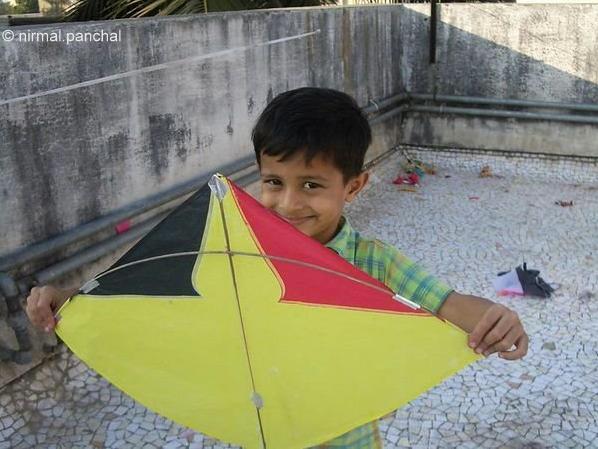
People on terrace...even before 14th Jan, practicing....

Malls and even small shops get into groove....look below


and whole day, kites color the sky....and in evening sky is......

Kite festival of gujarat





Harvest Festival PONGAL
The Festival originated in Tamil Nadu and popularly known as “Tamizhar Thirunal”. The festival is celebrated for four days to provide sincere thanks and prosperity that the farmers and his work which payed us..
First day Jan 13 - Bhogi
Bhogi is the first day of this harvest festival which is celebrated by throwing away and destroying old materials on fire thereby marking the end of the old and the emergence of the new.
Bhogi is the first day of this harvest festival which is celebrated by throwing away and destroying old materials on fire thereby marking the end of the old and the emergence of the new.
The second Pongal is the main day of the festival. It is celebreated by boiling rice with fresh milk and jaggery in new pots that are later topped with cashew nuts and sugar and allowing it to boil over the pot in the early morning. The moment the rice boils out of the pot, the tradition is to shout “Pongaloo pongal”. Sugar cane is bought and placed in every houses to symbolise the celebration of this great festival in Tamil Nadu.
The third day of the festival is known as “Maatu pongal” which is a occasion for offering thanks to cattle for their help to farmers in the field of Agriculture. On this cattle are well decorated with paint, flowers and bells and are allowed to roam. The cattle are then well fed with sweet rice and sugarcane.
Fourth day Jan 16 - Kaaanum Pongal
The final day “Kaanum pongal” is to thank the relatives and friends for their support. During this day people visit their friends and relatives to enjoy the pongal season.People flock together at beaches , parks and temples there by having a great day out.
The final day “Kaanum pongal” is to thank the relatives and friends for their support. During this day people visit their friends and relatives to enjoy the pongal season.People flock together at beaches , parks and temples there by having a great day out.
This four day Harvest Festival is to honor the farmers for their hard work.. May god bless them.. Wish you all a very happy and prosperous Pongal..
 The third day known as 'Mattu Pongal' is dedicated to the cattle as cowherds and shepherds pay thanks to their cows and bulls, wash them, paint their horns and cover them with shining metal caps. They are fed 'pongal' and tinkling bells are tied around their neck. Cattle races are conducted and in the game called 'Manji Virattu' groups of young men chase running bulls. Bull fights called 'Jallikattu' are also arranged at some places where young men have to take the money bags tied to the horns of ferocious bulls single-handedly and without the use of arms.
The third day known as 'Mattu Pongal' is dedicated to the cattle as cowherds and shepherds pay thanks to their cows and bulls, wash them, paint their horns and cover them with shining metal caps. They are fed 'pongal' and tinkling bells are tied around their neck. Cattle races are conducted and in the game called 'Manji Virattu' groups of young men chase running bulls. Bull fights called 'Jallikattu' are also arranged at some places where young men have to take the money bags tied to the horns of ferocious bulls single-handedly and without the use of arms.
↧
↧
Kautaliya's Chankaya Niti written with Ink & Wooden Pen by Piyush Goel
Imagination and creativity are always there in Piyush’s Mind, by now (Jan,2015) Piyush has completed 15 World Famous Books in 8 different Ways.
Following Books Written with Hands By Piyush Goel in Mirror Image in Different Ways.
- ShreeMadBhagvadGita in Hindi Language (Pen).
- ShreeMadBhagvadGita in English Language (Pen).
- Shree Durga Saptsatti in Sanskrit Language (Pen).
- Shree Sai Satcharitra in Hindi Language (Pen).
- Shree Sai Satcharitra in English Language (Pen).
- Sunder Kand (2 times)(Pen).
- Shree Ram Charitra Manas(only Doha,Sorte,and Chaupai)(Pen).
- Madhushala of Late Harbans Rai Bachchan father of Amitabh Bachchan. (In Hindi using Needle)
- Gitanjali of Rabindranath Tagore 1913 Nobel Prize Winner for Literature(In English using Mehndi Cone).
- Piyush Vani of Piyush Goel on Aluminium Sheet (Hindi and English/Iron Nail).
- Piyush Vani of Piyush Goel on Transparent Sheet(Hindi and English/Fabric Cone Liner).
- Panchtantra of Vishnu Sharma on A-4 White Paper(Hindi/Carbon Paper).
- Meri Ikyavan Kavitain of Shree Atal Bihari Vajpayee on Magic Sheet (Hindi/Wooden Pen).
- Chanakya Niti (Hindi/Ink & Wooden Pen).
Piyush Goel has written Kautilya’s Chanakya Niti with Ink and Wooden Pen,all 381 Sanskrit Slokas & 585 Suktiyan on 419 Pages and Thickness of Book is 7 Inches and weight of the Book 10 Kgs.
↧
Ohh! There is a chameleon on my head [Image]
↧
Wow! What a crazy hair style
↧
Paint Brush Creations By Piyush Goel
↧
↧
Alaa Wardi : One Man Synthesizer, Orchestra, Singer - "All in One"
Alaa Wardi : Musician, Composer, Singer, Songwriter & Audio Engineer.

Alaa Wardi (born c.1987) is an Saudi Arabia-based Iranian musician. Born and raised in Riyadh, Saudi Arabia, studied music and sound engineering in Amman, Jordan and is currently living in Riyadh. He is a musician, composer, singer, songwriter and audio engineer.
His music features a cappella singing, usually with human rhythmic accompaniment, including beatboxing. He became internationally known for his Hindi cover versions of Bollywood hits Pehla Nasha and Jiya Re. His music and videos are marketed via the internet on a voluntary contribution basis.
In 2011 he formed a band called Hayajan with four other Jordanian musicians (Odai Shawagfeh, Mohammed Idrei, Amjad Shahrouh and Hakam Abu Soud). Their Arabic language debut album, Ya bay was released in May 2013.
He produced the English language musical video "No Woman, No Drive" in October, 2013 with comedian Hisham Fageeh and Fahad Albutairi as a satirical comment on the Saudi Arabian ban on women drivers. It is sung a capella by Fageeh backed by Wardi and Albutairi to the tune of Bob Marley's "No Woman, No Cry" and has become a major YouTube hit.
↧
Amazing Swinging Rock In India - Greatest Geological Miracle
Swinging rock lying in such a manner that a single person can swing this thousands ton rock with legs. During high wind velocity it strikes near by rock making loud noise which is known to near by villagers that swinging rock is being effected by high wind velocity.The site is at Bhinmal of District Jalore ,Rajasthan ,India.
↧
Amazing Caterpillars : Weird, Beautiful, Colorful Caterpillars
Weird and Beautiful Caterpillars
Caterpillars are the larval form of members of the order Lepidoptera (the insect order comprising butterflies and moths). They are mostly herbivorous in food habit, although some species are insectivorous. Caterpillars are voracious feeders and many of them are considered to be pests in agriculture. Many moth species are better known in their caterpillar stages because of the damage they cause to fruits and other agricultural produce.
The etymological origins of the word are from the early 16th century, from Middle English catirpel, catirpeller, probably an alteration of Old North French catepelose: cate, cat (from Latin cattus) + pelose, hairy (from Latin pilo-sus).
Some Caterpillars are easy to identify because they have some unique characteristic, but most are rather similar to each other. Most taxonomy has been performed using the adult forms, so the only sure way to determine their species is to rear them through to the adult butterfly or moth, and then identify that.
Some caterpillars can be identified to the individual species.
Some can only be identified easily to the family.
Some are not true Caterpillars at all.
Amazing & Colorful Caterpillar Photos
↧
The Royal Wedding 2011 : Prince William of Wales and Kate Middleton Royal Wedding - 29 April 2011
Royal Wedding of Prince William of Wales and Kate Middleton - 29 April 2011
The Royal Wedding 2011
The wedding of Prince William of Wales and Catherine "Kate" Middleton is scheduled to take place at Westminster Abbey on 29 April 2011 at 11am. Prince William, who is second in the line of succession to Queen Elizabeth II, first met Middleton in 2001, while both were students at the University of St Andrews. Their engagement, which began on 20 October 2010, was announced on 16 November 2010.
After the wedding, the couple intend to continue residing on the Isle of Anglesey in North Wales, where Prince William is based as an RAF Search and Rescue pilot.
On 16 November 2010, Clarence House announced that Prince William, elder son of the Prince of Wales, was to marry his long-time girlfriend Kate Middleton "in the Spring or Summer of 2011, in London". They were engaged in October 2010 while on a private holiday in Kenya; William gave Middleton the same engagement ring that his father had given to William's mother, Diana, Princess of Wales—an 18-carat white gold ring with a 12-carat oval sapphire and 14 round diamonds. It was announced at approximately the same time that, after their marriage, the couple will live on the Isle of Anglesey in Wales, where Prince William is based with the Royal Air Force.
Prince William is the elder son of Prince Charles, Prince of Wales, and Diana, Princess of Wales, and grandson of Queen Elizabeth II and Prince Philip, Duke of Edinburgh. As such, he is second, behind his father, in the line of succession to the throne in 16 independent states known as the Commonwealth realms. William was educated at Ludgrove School, Eton College, and the University of St Andrews, after which he was commissioned as an officer from Sandhurst in the Blues and Royals regiment of the Household Cavalry. He later transferred to the RAF and went on to become a full-time pilot with the Search and Rescue Force at RAF Valley, Anglesey.
Catherine "Kate" Middleton is the eldest of three children born to Michael and Carole Middleton. She was educated at St Andrew's School in Pangbourne, Marlborough College, and the University of St Andrews. After graduating, she worked in retail and then as an accessories buyer/catalogue photographer at her parents' business. She is primarily of English descent, but with a few distant Scottish and French Huguenot ancestors. Her paternal family came from Leeds, West Yorkshire, while her mother's maternal family, the Harrisons, were working-class labourers and miners from County Durham.
The couple met while undergraduates at the University of St Andrews, where they both lived at St Salvator's Hall during their first year, after which they shared accommodation in the town for two years. They are fifteenth cousins—having Sir Thomas Fairfax and his wife, Agnes, as common ancestors—and are possibly twelfth cousins once removed, circumstantial evidence suggesting that they are both descended from Sir Thomas Leighton and Elizabeth Knollys.
Timings/Schedule of The Royal Wedding Day
At 6.00 am roads in and around the processional route close to traffic.From 8.15 am, the main congregation, governors-general, prime ministers of Commonwealth realms, and diplomats, will all arrive at the Abbey.
Princes William and Harry are then due to leave Clarence House at 10.10 am, and arrive by 10.15 am, followed by representatives of foreign royal families, the Middleton family, and, lastly, the Prince's own family (the Princess Royal, the Duke of York, Princess Beatrice of York, Princess Eugenie of York, the Earl and Countess of Wessex, Vice Admiral Timothy Laurence, the Prince of Wales and the Duchess of Cornwall).
By tradition, the Queen and the Duke of Edinburgh will be the last members of the Royal Family to leave Buckingham Palace, arriving at the Abbey for 10.45 am.
The bridal party will then leave the Goring Hotel in the former Number one state Rolls-Royce Phantom VI at 10.50 am, in time for the service to begin at 11 am.
The service is to finish at 12.15 pm, after which the newly married couple will travel to Buckingham Palace in a procession consisting of other royal family members, the parents of the groom and bride, the best man, and the bridesmaids.
At 1.25 pm, the couple will appear at the Buckingham Palace balcony to watch a fly-past consisting of Lancaster, Spitfire, and Hurricane aircraft from the Battle of Britain Memorial Flight, followed by two Typhoons and two Tornado GR4s.
Important Things and Information about The Royal Wedding of Prince William of Wales and Kate Middleton
Archbishop of Canterbury
Meet Dr. Rowan Williams, the spiritual leader of the Anglican Church of England who will officiate William and Kate's wedding. A published poet and Simpsons fan, Dr. Williams follows in a long line of archbishops (he's the 104th) who've traditionally married the monarchs-to-be. Another claim to fame: Dr. Williams shares a birthplace (Swansea, Wales) with an Oscar winner, Catherine Zeta-Jones.
Bucklebury
Once the royal manor of 11th-century king Edward the Confessor and a station for troops during World War II, the quaint but affluent village 55 miles west of London where Kate Middleton grew up last made headlines in 2008, when Prince William landed a helicopter there to visit his girlfriend. Watch a guided tour of the place Kate calls home – and meet some of the town folk, who weigh in on its most famous resident's upcoming wedding to the future king of England.
Catherine
Though she goes by Kate, Catherine Elizabeth Middleton shares a name with an illustrious group of women, including five previous queens of England! The name (meaning pure in Greek) gained popularity during the Crusades and since then, many great Kates have made their mark on history – among them Catherine de Medici, Catherine the Great and Catherine of Aragon, a wife of Henry the VIII.
Dukedom
If tradition is to be carried down, William will receive a new title on his wedding day – a royal protocol observed when his uncles married: Prince Andrew became Duke of York when he said "I do" to Fergie in 1986, while Prince Edward earned the title of Earl of Wessex when he wed Sophie Rhys-Jones in 1999. Many titles are still up for grabs – from the Dukedom of Sussex ( a front-runner) to the Duke of Cambridge – and it will be up to William's granny, Queen Elizabeth, to determine where he presides.
Ellen DeGeneres
With friends and hangers-on vying for an invite to what's to be sure the wedding of the year, the beloved talk show queen has a legitimate claim for an invitation: She's related to Kate Middleton! Sure, they are distant cousins – 15th! – but family is family, so says The New England Historic Genealogical Society, who traced their ties.
Fruitcake
The much-maligned dessert has a storied history, reportedly dating back to ancient Egypt, when it was placed on the tombs of loved ones going into the afterlife. Filled with fruits and nuts – symbols of fertility – it was even outlawed briefly in the 18th century for being sinfully rich, but the ban was short-lived as Victorian-era Britons demanded their cake during tea hour. Now, the sweet treat has become a wedding reception favorite among English couples, and Will and Kate could be the next to bite into it!
Good Luck Charms
Kate Middleton may be allergic to horses, but the princess-to-be could very well carry a horseshoe charm sewn onto the hem of her dress as a symbol of good luck – just as Diana had onto hers – when she weds Prince William. Or perhaps she'll carry a silver sixpence, as in "something borrowed, something blue, and a silver sixpence in your shoe," a practice that originated in Victorian times.
Harry
Now the most eligible royal bachelor on the market – and third in line to the British throne! – Prince Henry Charles Albert David Windsor is not only William's brother but also his best man. And he's been living up to both roles, in championing Kate Middleton ("I get a sister," he's said) and in continuing his late mother Diana's charitable works, all while serving his country as a lieutenant in the British Army.
Issa
The London-based designer of Kate Middleton's must-have, blue engagement dress has always maintained she designs clothes for real women – and apparently, for real-life princesses-to-be! Ten years after launching her label, Brazilian-born Daniella Helayel's signature draped jersey dresses have won over a Hollywood fan base that includes Madonna, Gwen Stefani and Scarlett Johansson. But it was Middleton's blue dress, which sold out almost instantly, that turned the label into an international household name.
Wedding Jewelry
Since the reign of Queen Victoria more than 160 years ago, Garrard has been the official crown jeweler. Though Queen Elizabeth distanced the royal family's ties to the esteemed London jewelry house in 2007, reportedly after being less than impressed with the company's racy new image, William and Kate could have their wedding rings made by jewelry house. After all, Garrard made the late Princess Diana's iconic sapphire engagement ring – the one that's now sparkling on Kate Middleton's finger.
Kenya
The country where William popped the question to Kate Middleton during a romantic fishing trip on Lake Rutundu is near and dear to the future king. "Africa is my second home," he has said of the continent where he spent his gap year and took his fiancée on safari early in their courtship.
Lady-in-Waiting
Traditionally friends or relatives, ladies-in-waiting serve as a right-hand woman to a royal, and for Kate, it seems her sister Pippa would be the perfect choice. The younger sibling, 27, will be Kate's maid of honor on the big day, but her responsibilities would expand once Kate becomes a princess, including traveling and attending official engagements with her. If Kate does secure Pippa as her lady-in-waiting, she'll be in good company: Both Princess Diana and Camilla Parker Bowles enlisted their sisters for help.
Mahiki
Will and Kate's favorite nightclub for Polynesian fun was once managed by the Prince's wingman Guy Pelly, who's also planning the royal bachelor party. But the Dover Street nightspot isn't the only exclusive London club frequented by the couple – they've partied till the wee hours at Chinawhite, Volstead and Boujis, the club in which the pair went on a secret date following their brief split in 2007.
North Wales
Instead of one of the many royal residences at his family's disposal, Prince William and Kate Middleton have made their home in a four-bedroom farmhouse in this quaint, sheep-laden region complete with a gastro pub and a Tesco supermarket where locals often catch a glimpse of the down-to-earth couple. And they'll be seeing more of the young newlyweds – the Prince has another two years to complete his duties as a helicopter pilot with the Royal Air Force.
Bruce Oldfield
A front-runner to design Kate's wedding dress, Bruce Oldfield is an established name among the royal and high society set. Plus, the 60-year-old couturier to William's late mum Diana has been backed as the perfect choice to design Kate's gown by none other than Elizabeth Emanuel, who outfitted the Princess of Wales on her wedding day 30 years earlier. Further fueling rumors that Oldfield could be The One: Kate's mum Carole and sister Pippa were spotted at one of his stores.
Philip Treacy
For two decades, the Irish milliner has enchanted Hollywood and real-life royalty, including Sarah Jessica Parker, Lady Gaga, Kate Middleton and Princess Beatrice, with his fanciful headpieces. While William and Kate will be the main event on April 29, the side show will most certainly be the parade of head-turning hats – from futuristic discs and a riot of floral toppers to a butterfly colony – adorning the heads of their wedding guests, a custom still observed by Britons for weddings and worship.
Queen Elizabeth II
At 84, she is Britain's oldest monarch, having ruled the throne since February 1952, when she was just 25 years old. But don’t be fooled, the octogenarian – who is known for her ingeniously discreet communication tactics – is very much in touch with modern times. You can find Her Majesty social networking on Flickr, YouTube, and yes, even Twitter.
The Royal Mint
Not invited to William and Kate's wedding? The average commoner can still celebrate the occasion – with the first-ever Royal Engagement coin issued by the Royal Mint to commemorate the young couple's betrothal. While critics argue the likeness of Kate Middleton on the £5 coin bears little resemblance to the actual princess-to-be, the design received the royal seal of approval from Prince William and Her Majesty the Queen. Luckily for Kate, it's a limited-edition coin.
St. Andrews
Known as the U.K.'s "top match-making university," is it a wonder the future king and queen fell in love there? The Scottish burgh is where they spent nights out at local pubs and a pizza joint, and also enjoyed dates under aliases at a boutique hotel restaurant. That occasion had Kate playing by the rules of many a college girl: Despite dating a British royal, when it came time for the check, the couple went dutch!
Tiara
When Kate Middleton walks down the aisle of Westminster Abbey to marry Prince William, she will certainly look the part of royalty. But no royal wedding attire is complete without a crown jewel befitting a princess-to-be. Queen Elizabeth and William's late mum Diana both wore stunning tiaras on their wedding days – and it's likely William's granny will at the very least loan (if not gift) one of the many glittering headpieces in the Windsor vault to his future wife.
Usher
Prince William has been an usher at some of his best friends' weddings, but sadly for them, they won't get the chance to return the favor. That's because the role of helping ceremony guests to their pews at Westminster Abbey will go to a 10-member group of paid Gentlemen Ushers, a tradition that dates back to the 15th century.
Vows
For the ultra-modern among us hoping for self-penned vows in which William and Kate utter intimate, personal promises to one another, there will be disappointment. The couple will pick one of two sets of traditional vows on their wedding day: old verses from the Book of Common Prayer of 1662 or the not-so-old ones in The Book of Common Worship, which is widely used today in the Protestant Church of England.
Westminster Abbey
The Abbey has held close ties with the British monarchy since the days of King Edward the Confessor, who founded the 11th-century Gothic church. It's been the site of many glorious royal coronations, burials and weddings, with the earliest dating back to 1100, when King Henry I married Princess Matilda of Scotland. Queen Elizabeth, her daughter Princess Anne and son Prince Andrew all married at Westminster, so it's fitting that her grandson, Prince William, will follow in Windsor suit.
Kiss Me Kate Beer
Xoxo! With the biggest royal wedding since Charles and Di taking over London, leave it to Nottingham, England's largest beer company, Castle Rock Brewery, to toast the happy occasion in its own way – with a new, limited-edition ale! The royal tipple is described as "elegant, tasteful and British to the core"– much like Will and Kate. We'll drink to that!
Your Majesty
Don't call her that! When Kate becomes an official royal on her wedding day, the proper way to refer to her will be Her Royal Highness, or HRH – a "style" that commonly precedes the names of princes and princesses in the British monarchy. So, as of April 29, Kate will take on a much longer name: HRH Princess William of Wales, while informally, she'll be Princess Catherine. Here's hoping she registers for some new stationery!
Zermatt
It was here that William and Kate debuted their PDA during a weeklong Swiss Alps ski vacation at the resort town Zermatt in March 2007 – but just a month later the couple split. Relive the pair's famously private courtship and brief public breakup and see how, eight years after meeting as coeds at St. Andrews University in Scotland, they're making it all official.
Courtesy: http://www.people.com, http://en.wikipedia.org
Photos of Royal wedding dignitaries and VIPs
Photos of the royal wedding crowds
Photos of the royal marriage ceremony


Photos of Royal Couple Prince William of Wales and Kate Middleton
↧
↧
Amazing Tombs - Most Famous, Amazing, Fascinating And Historically Significant Tombs In The World
A tomb is a place for the burial of the dead. Some people consider tombs or burial sites scary for they believe that the place is a dwelling place for ghost. On the other hand, many people consider them amazing and fascinating. Here are the 10 most interesting and historically important tombs in the world.
One single tomb that can be considered famous and significant is the Tomb of Mausolus. It is called Mausoleum of Mausolus or Mausoleum at Halicarnassus. It was a tomb built between 353 and 350 BC at Halicarnassus (present Bodrum, Turkey) for Mausolus, a satrap (governor) in the Persian Empire, and Artemisia II of Caria, his wife and sister. The structure was designed by the Greek architects Satyrus and Pythius. It stood approximately 45 meters (135 ft) in height, and each of the four sides was adorned with sculptural relief created by each one of four Greek sculptors - Leochares, Bryaxis, Scopas of Paros and Timotheus. The Mausoleum stood relatively intact until 1522 A.D., when it was ordered destroyed as an example of Pagan art.
The finished structure was considered to be such an aesthetic triumph that Antipater of Sidon identified it as one of his 7 Wonders of the Ancient World.
Another famous tomb is the Mausoleum of Hadrian, usually known as the Castel Sant'Angelo. It is a towering cylindrical building in Rome, initially commissioned by the Roman Emperor Hadrian as a mausoleum for himself and his family. The building was later used as a fortress and castle, and is now a museum. The tomb of the Roman emperor Hadrian was erected on the right bank of the Tiber, between 135 and 139. Originally the mausoleum was a decorated cylinder, with a garden top and golden quadriga. Hadrian's ashes were placed here a year after his death in 138, together with those of his wife Sabina, and his first adopted son, Lucius Aelius, who also died in 138. Following this, the remains of succeeding emperors were also placed here, the last recorded deposition being Caracalla in 217.
A tomb that is significantly famous especially among the Russians is Lenin's Mausoleum. It is also known as Lenin's Tomb situated in Red Square in Moscow. This mausoleum is popular because the embalmed body of Lenin has been on public display there since the year he died in 1924 (with rare exceptions in wartime). It is the mausoleum that serves as the current resting place of Vladimir Lenin. Aleksey Schusev's diminutive but monumental granite structure incorporates some elements from ancient mausoleums, such as the Step Pyramid and the Tomb of Cyrus the Great.
Undoubtedly, Taj Mahal is one of the most famous tombs worldwide. It is a mausoleum located in Agra, India, that was built under Mogul Emperor Shah Jahan in memory of his favorite wife, Mumtaz Mahal. In 1983, the Taj Mahal became a UNESCO World Heritage Site and was cited as “the jewel of Muslim art in India and one of the universally admired masterpieces of the world's heritage.”
Grant's Tomb: New York, USA
A tomb with great importance most especially among the Americans is General Grant National Memorial better known as Grant's Tomb. It is a mausoleum containing the bodies of Ulysses S. Grant (1822-1885), an American Civil War General and the 18th President of the United States, and his wife, Julia Dent Grant (1826-1902). The tomb complex is a US Presidential Memorial in the Morning Heights neighborhood of Manhattan in New York City. The structure is situated in a prominent location in Riverside Park overlooking the Hudson River.
Another important and with historical significance tomb is the Pantheon which was originally built for the all gods. Literally means "Temple of all the gods” is a building in Rome. It was rebuilt circa 125 AD during Hadrian's reign. The intended degree of inclusiveness of this dedication is debated. The generic term pantheon is now applied to a monument in which illustrious dead are buried. Pantheon is the best preserved of all Roman buildings, and perhaps the best preserved building of its age in the world. It has been in continuous use throughout its history.
Since the Renaissance the Pantheon has been used as a tomb. Among those buried there are the painter Raphael and Annibale Carracci, the composer Arcangelo Corelli, and the architect Baldassare Peruzzi. Also buried there are two kings of Italy: Vittorio Emmanuelle II and Umberto I, as well as Umberto's Queen, Margherita.
Looking at this structure, there is no way you will think that it's a burial place. The Collegiate Church of St Peter at Westminster, which is almost always referred to by its original name of Westminster Abbey, is a large, mainly Gothic church, in Westminster, London, just to the west of the Palace of Westminster. It is the traditional place of coronation and burial site for English and later British monarchs.
Aristocrats were buried inside chapels and monks and people associated with the Abbey were buried in the Cloisters and other areas. One of these was Geoffrey Chaucer, who was buried here as he had apartments in the Abbey where he was employed as master of the Kings Works. Other poets were buried around Chaucer in what became known as Poet's Corner. These include John Milton, William Wordsworth, Thomas Gray, John Keats, Percy Bysshe, Robert Burns, William Blake, T.S. Elliot and Gerard Manley Hopkins and many others.
In Catholic tradition, it is the burial site of its namesake Saint Peter, who was one of the 12 apostles of Jesus and, according to tradition, was the first Bishop of Antioch, and later first and therefore first in the line of the papal succession. St. Peter' is the most famous of Rome's any churches.
There are over 100 tombs within St. Peter's Basilica, many located in the Vatican grotto, beneath the Basilica. These include 91 popes, St. Ignatius of Antioch, Holy Roman Emperor Otto II, and the composer Giovanni Pierluigi da Palestrina. Exiled Catholic British royalty James Francis Edward Stuart and his two sons, Charles Edward Stuart and Henry Benedict Stuart, are buried here, having been granted asylum by Pope Clement XI. Also buried here are Maria Clementina Sobieska, wife of Charles Edward Stuart, and Queen Christina of Sweden, who abdicated her throne in order to convert to Catholicism. The most recent interment was Pope John Paul II, on April 8, 2005.
This ancient tomb excavated in Pasargadae, a city in ancient Persia, is believed to be the tomb of one of the most notable king of Persia - King Cyrus the Great. It is today an archeological site and one of only five of Iran's UNESCO World Heritage Sites. According to the Elamite cuneiform of the Persepolis fortification tablets the name was rendered as Batrakatas and the name in current usage derives from a Greek transliteration of an Old Persian Pathragada toponym of still-uncertain meaning.
Great Pyramid of Giza: Egypt
The Great Pyramid of Giza is the only remaining member of the 7 Wonders of the Ancient World. It is also called Khufu's Pyramid or the Pyramid of Khufu, and Pyramid of Cheops. This tomb with great popularity and historical significance is the oldest and largest of the three pyramids in the Giza Necropolis. It is believed the pyramid was built as a tomb for 4th Egyptian pharaoh Khufu (Cheops in Greek) and constructed over a 20 year period concluding around 2560 BC. The Great Pyramid was the tallest man-made structure in the world for over 3,800 years.
The Tomb of Jesus Christ is not included on the list because it is still a subject of much controversy and scrutiny. Once it is proven that it was indeed the Tomb of Christ, it will surely be considered the tomb with the greatest significance and will surely escalate to the highest and unsurpassable degree of popularity.
One of the basic reasons why some of these magnificent tombs were built is because of people's belief on life after death. Given the chance to choose before you pass away, where on these burial sites would you like to be buried?
↧
Amazing Rat Temple - Deshnok Karni Mata Temple where Rats Rule at Indian Temple
Amazing Rat Temple - Karni Mata Temple, Deshnok, Bikaner, Rajasthan, India
The floors are a living tangle of undulating fur. Small, brown blurs scurry across marble floors. Thousands of rats dine with people and scamper over their feet. It may sound like a nightmare from the New York City subway to some, but in India's small northwestern city of Deshnoke, this is a place of worship: Rajastan's famous Karni Mata Temple.
Karni Mata was a female Hindu sage born in the Charan caste and is worshiped as the incarnation of the goddess Durga by her followers. She is an official deity of the royal family of Jodhpur and Bikaner. During her lifetime, she laid the foundation stone of two of the important forts in Rajputana. She lived an ascetic life, and most of the temples dedicated to her were dedicated during her lifetime. A temple dedicated to her during her lifetime differs from others in that it does not contain an image or idol of her but rather contains a foot-print to symbolize her visit to that place. The most famous of her temples is the temple of Deshnoke, which was created following her mysterious disappearance from her home. The temple is famous for its rats, which are treated as sacred and given protection in the temple. This temple is near to Bikaner and Nokha. The second name of Karni mata is (Nari bai). Contrary to some reports, the temple is of the Hindu sect and is not affiliated with the Jain faith.
Karni Mata temple, Deshnoke
The Karni Mata temple at Deshnoke, 30 km from Bikaner, in its present form was completed in the early 20th century in the late Mughal style by Maharaja Ganga Singh of Bikaner. The temple was further enhanced by Kundanlal Verma of Hyderabad-based Karni Jewelers in 1999. The huge silver gates to the temple and the marble carvings were also donated by him.
Throughout the year, pilgrims from around India visit to pay religious tribute to Karni Mata at the Deshnoke temple. Outside Rajasthan, she is respected and loved in areas such as Gujarat, Madhya Pradesh, and Haryana. During Navratri thousands of people travel to the temple by foot. If one of the rats is killed, it must be replaced with one made of solid gold. Sighting a white rat amidst hordes of black rats is considered specially auspicious.
The legend
Karni Mata lived in the 14th century and performed many miracles during her life-time. When her youngest son, Lakhan, drowned, Karni Mata ordered Yama, the god of Death, to bring him back to life. Yama replied that he was unable to do this, but that Karni Mata, is an incarnation of Durga, could restore Lakhan's life. This she did, and decreed that members of her family would no longer die, but would be incarnated as kabas (rats), and these kabas would returns as members of her family. There are around 600 families in Deshnok who claim both decent from Karni Mata and that they will be reincarnated as kabas.
The temple is an important place of pilgrimage, with pilgrims being disgorged every few minutes from buses. Before the temple, is a beautiful marble facade with solid silver doors donated by Maharaja Gaj Singh. Across the doorway to the inner sanctum are the repousse (raised relief) silver doors - one panel shows the goddess with her holy charges at her feet. An image of goddess is enshrined in the sanctum. There are special holes around the temple courtyard to fascinate the rats' movements, and a wire grille has been placed over the courtyard to prevent the birds of prey and other predators consuming the holy rodents.
It is considered quite auspicious to have a kaba run across your feet. White kabas are quite rare, albeit there are one or two at the temple and sightseeing one augurs well for your spiritual progress.
↧
Burj Al Arab Hotel Dubai - Worlds First Most Luxurious And Only 7-Star Hotel

Burj Al Arab Hotel, Dubai, which was opened in 1999, is unofficially billed as a 7-star hotel and is the world's most luxurious and tallest hotel.
Designed to resemble a billowing sail, the hotel soars to a height of 321 metres, dominating the Dubai coastline. The hotel's own website describes it as the best in the world. With your chauffeur driven Rolls Royce, discreet in-suite check in, private reception desk on every floor and a brigade of highly trained butlers who provide around-the-clock attention, this hotel promises the finest the world has to offer.
The Burj Al Arab stands on an artificial island 280 m (920 ft) out from Jumeirah beach, and is connected to the mainland by a private curving bridge. It is an iconic structure, designed to symbolize Dubai's urban transformation and to mimic the sail of a boat.
Here are a selection of pictures to give you a taste of what you can look forward to as a guest.

Al Falak Ballroom

Al Mahara Restaurant

Royal Suite

Royal Suite

Royal Suite

Jacuzzi

Atrium

The Lobby

The view at night, when it is surrounded by color sculptures
of water and fire














↧
Sultan Of Brunei - Hassanal Bolkiah, One Of The Richest Royals In The World
Sultan Of Brunei - Hassanal Bolkiah
One Of The Richest Royals In The World
Sultanate of Brunei / sultanat de Brunei Dar Essalam / سلطنة بروناي
Haji Hassanal Bolkiah Mu?izzaddin Waddaulah, (full name: Sultan Haji Hassanal Bolkiah Mu'izzaddin Waddaulah ibni Al-Marhum Sultan Haji Omar Ali Saifuddien Sa'adul Khairi Waddien; born 15 July 1946 Brunei Town [now Bandar Seri Begawan], Brunei)), 29th sultan of Brunei.
Hassanal Bolkiah was the eldest son of Sultan Sir Haji Omar Ali Saifuddin. He was educated privately and later attended the Victoria Institution in Kuala Lumpur, Malaysia, and the Royal Military Academy at Sandhurst, England. In 1961 Sir Omar named him crown prince, and when Sir Omar abdicated six years later, Hassanal Bolkiah became sultan on October 5, 1967, his coronation taking place on August 1, 1968. For the next decade, however, his father remained the power behind the throne. After the death of his mother in 1979, his father withdrew from public affairs, and the sultan quickly took the dominant role in the administration of Brunei. He made frequent trips throughout the country to listen to his subjects as well as to promote himself as ruler. In anticipation of independence from Britain, he began to create a native bureaucracy, replacing British expatriates in the civil service with Bruneians, and he cracked down on corruption.
After having held Brunei as a protectorate for 95 years, the British formally withdrew on January 1, 1984. Although there were minor disagreements over matters such as the management of Brunei’s huge investment portfolio, relations between the two countries continued to be friendly. Sir Omar died in 1986, and on October 5, 1992, the sultan, who also acted as prime minister and as the minister of defense and of finance, celebrated the 25th year of his reign. He continued to rule under a state of emergency declared by his father in 1962. In the 1980s and 1990s the sultan regularly appeared at or near the top of lists of the world’s richest individuals, his fortune deriving from Brunei’s oil and gas. The Sultan of Brunei, (also known as Hassanai Bolkiah Mu’izzaddin Waddaulah) has an estimated net worth of $20 billion, and rightly so.
Apart from essentially running Brunei, Bolkiah makes time to focus on his collection of automobiles. Sultan of Brunei has one of the largest car collections in world- about 7000. Bolkiah also has a Boeing 747 for his own use, as well as a theme park called Jerudong Park.
The Sultan is known for some familial conflicts, particularly with his brother, Prince Jefri Bolkiah, who is known as the “Playboy Prince.” The two were involved in a legal argument which was eventually settled in 2006. With his honorary titles, net worth, and astonishing power and control, Bolkiah has made his mark on history, as well as made us all jealous with his lavish and unique lifestyle.
Hassanal Bolkiah's impressive collection (stored in five garages the size of airplane hangars) includes:
* 531 Mercedes-Benzes
* 367 Ferraris
* 362 Bentleys
* 185 BMWs
* 177 Jaguars
* 160 Porsches
* 130 Rolls-Royces
* 20 Lamborghinis
The cars are driven by the Sultan, members of his family, and also by the ministers of state, government officials and other members of the royal household.
His auto empire includes 350 Rolls-Royce cars, eight McLaren's F1, six Dauer 962 LMs, the only right-handed Mercedes CLK-GTR in the world, a Lamborghini Diablo Jota, two Jaguar XJR-15, numerous Ferraris, Mercedes, Jaguars, Porsches, Bentleys. In the past 15 years, Sultan has been a regular client for prestige car companies. For example, only Rolls-Royce provided 40-50 cars a year for his majesty and Aston Martin has sold over 300 cars during these years. His special interest are unique cars, such as Bentley Java and Bentley Dominator 4x4. His Aston Martin collection includes: Aston Martin AM3, Aston Martin DB7 by Pininfarina, Aston Martin V8 AM2 by Pininfarina. Six bullet-proof Rolls-Royce Phantoms are also in his possession.
McLaren F1s
The Sultan's has eight F1s, including GT and LM editions. In 1995 McLaren made history by winning the 24-hour Le Mans race at their first attempt. To celebrate, they built five LM's, one for every F1 which finished the event. The Sultan has three of them.
Dauer 962 LMs
The Dauer racing team's prototype Porsche 962 (see image at the top of this page) is the world's fastest road car. The 2,994cc water-cooled Porsche flat-six engine will take you from 0-60mph in 2.6 seconds. Six of the cars rest in the Sultan's garages.
Mercedes CLK-GTR
Built to enter the 1997 FIA GT Championship, the 200mph CLK-GTR won all World Championship titles it entered in 1997 and 1998. With a V12 engine mounted behind the passenger compartment, The Sultan owns the only right-hand drive Mercedes CLK-GTR in the world.
Lamborghini Diablo SE Jota
Only 50 XJR-15s were ever made, selling for almost $1 million each. Based on another Le Mans-winning motor, the rear-wheel drive supercar packs a 450bhp, 5,993cc V12 engine and a top speed of 185mph. In 1991, sixteen XJR-15s in a Jaguar only race in Monaco - the race had a prize of $1 million.
Stretch Range Rover Classic
Even his Range Rover, a custom-built stretch Classic has an opulent edge to put most hotels to shame. Made for the Sultan by British coachbuilders Townley, the enlongated Rangie has a full blood red leather interior, Champagne buckets, two TVs, power seats, tinted windows and an electronically operated division glass between the driver and passenger compartments.
The garage of the Sultan of Brunei
Sultan Of Brunei Private Airplane
Sultan bought this Airbus 340 for roughly USD 220 Million RM99.90, the plane comes fully equipped with a Gold Plated Sink.Just look at the huge amount of luxury from that plane, if a fully equiped flying house.
Al-Mu'izzaddin Waddaulah ibni Almarhum Sultan Omar Ali Saifuddin, GCMG (born July 15, 1946) is the 29th Sultan of Brunei, the eldest son of Omar Ali Saifuddin Sa'adul Khairi Waddien, the previous sultan.
Crown Prince Al-Muhtadee Billah Bolkiah is the sultan's heir, born by Queen Saleha. By 2005 he had four sons and six daughters with Queen Saleha and his former second wife, Queen Mariam. In accordance with Islam, Bruneian men are allowed four wives, but the sultan only has two, with Queen Anak Saleha being designated his first wife. His first second wife, Queen Mariam, was a former air hostess whom he divorced in 2003, stripping her of all her royal titles. In August 2005 her place was taken by a former Malaysian TV3 presenter, Azrinaz Mazhar Hakim, who is 32 years younger than the sultan.
Al-Mu'izzaddin Waddaulah ibni Almarhum Sultan Omar Ali Saifuddin, GCMG (born July 15, 1946) is the 29th Sultan of Brunei, the eldest son of Omar Ali Saifuddin Sa'adul Khairi Waddien, the previous sultan.
Crown Prince Al-Muhtadee Billah Bolkiah is the sultan's heir, born by Queen Saleha. By 2005 he had four sons and six daughters with Queen Saleha and his former second wife, Queen Mariam. In accordance with Islam, Bruneian men are allowed four wives, but the sultan only has two, with Queen Anak Saleha being designated his first wife. His first second wife, Queen Mariam, was a former air hostess whom he divorced in 2003, stripping her of all her royal titles. In August 2005 her place was taken by a former Malaysian TV3 presenter, Azrinaz Mazhar Hakim, who is 32 years younger than the sultan.
Palace of Sultan Of Brunei
Sultan Of Brunei Pictures
↧
↧
Royal Bengal Tiger - Bengal Tiger Facts, Profile, Photos, Information, Habitats, News
Royal Bengal tiger - Panthera tigris tigris
Tigers are the largest members of the cat family and are renowned for their power and strength.
There were eight tiger subspecies at one time, but three became extinct during the 20th century. Over the last 100 years, hunting and forest destruction have reduced tiger populations from hundreds of thousands of animals to perhaps fewer than 2,500. Tigers are hunted as trophies, and also for body parts that are used in traditional Chinese medicine. All five remaining tiger subspecies are endangered, and many protection programs are in place.
The Bengal tiger, or Royal Bengal tiger (Panthera tigris tigris), is a tiger subspecies native to India, Bangladesh, Nepal and Bhutan, and has been classified as endangered by IUCN as the population is estimated at fewer than 2,500 individuals with a decreasing trend. None of the Tiger Conservation Landscapes within the Bengal's tiger range is large enough to support an effective population size of 250.
The Bengal tiger is the most numerous of the tiger subspecies — with populations estimated at 1,706 in India, 200 in Bangladesh, 155 in Nepal and 67–81 in Bhutan.
The Bengal tiger is the national animal of Bangladesh. Panthera tigris is the national animal of India.
Bengal tigers live in India and are sometimes called Indian tigers. They are the most common tiger and number about half of all wild tigers. Over many centuries they have become an important part of Indian tradition and lore.
Tigers live alone and aggressively scent-mark large territories to keep their rivals away. They are powerful nocturnal hunters that travel many miles to find buffalo, deer, wild pigs, and other large mammals. Tigers use their distinctive coats as camouflage (no two have exactly the same stripes). They lie in wait and creep close enough to attack their victims with a quick spring and a fatal pounce. A hungry tiger can eat as much as 60 pounds (27 kilograms) in one night, though they usually eat less.
Despite their fearsome reputation, most tigers avoid humans; however, a few do become dangerous maneaters. These animals are often sick and unable to hunt normally, or live in an area where their traditional prey has vanished.
Females give birth to litters of two to six cubs, which they raise with little or no help from the male. Cubs cannot hunt until they are 18 months old and remain with their mothers for two to three years, when they disperse to find their own territory.
Fast Facts about Royal Bengal tiger
Type: Mammal
Diet: Carnivore
Average life span in the wild: 8 to 10 years
Size: Head and body, 5 to 6 ft (1.5 to 1.8 m); tail, 2 to 3 ft (0.6 to 0.9 m)
Weight: 240 to 500 lbs (109 to 227 kg)
Protection status: Endangered
Did you know? - A tiger's roar can be heard as far as 2 mi (3 km) away.
Courtesy : http://animals.nationalgeographic.com
↧
7 Wonders of the World - New vs. Ancient
7 Wonders of the World - New vs. Ancient
New 7 Wonders of the World
New 7 Wonders of the World
Christ the Redeemer Statue
The 105-foot-tall (38-meter-tall) "Christ the Redeemer" statue in Rio de Janeiro, Brazil, was among the "new seven wonders of the world" announced July 7 following a global poll to decide a new list of human-made marvels.
The winners were voted for by Internet and phone, American Idol style. The other six new wonders are the Colosseum in Rome, India's Taj Mahal, the Great Wall of China, Jordan's ancient city of Petra, the Inca ruins of Machu Picchu in Peru, and the ancient Maya city of Chichén Itzá in Mexico.
The contest was organized by the New7Wonders Foundation—the brainchild of Swiss filmmaker and museum curator Bernard Weber—in order to "protect humankind's heritage across the globe." The foundation says the poll attracted almost a hundred million votes.
Yet the competition has proved controversial, drawing criticism from the United Nations' cultural organization UNESCO, which administers the World Heritage sites program.
"This initiative cannot, in any significant and sustainable manner, contribute to the preservation of sites elected by [the] public," UNESCO said in a statement.
Great Wall of China
This newly elected world wonder was built along China's northern border over many centuries to keep out invading Mongol tribes.
Constructed between the fifth century B.C. and the 16th century, the Great Wall is the world's longest human-made structure, stretching some 4,000 miles (6,400 kilometers). The best known section was built around 200 B.C. by the first emperor of China, Qin Shi Huang Di.
The wall was among the winners of the New7Wonders poll announced during a televised ceremony in Lisbon, Portugal. However the Chinese state broadcaster chose not to broadcast the event, and Chinese state heritage officials refused to endorse the competition.
It was a different story for some of the other candidates. In Brazil, for example, President Luiz Inácio Lula da Silva encouraged his compatriots to vote for Rio de Janeiro's mountaintop statue of Jesus Christ.
The Colosseum, Rome, Italy
The only finalist from Europe to make it into the top seven—the Colosseum in Rome, Italy—once held up to 50,000 spectators who came to watch gory games involving gladiators, wild animals, and prisoners.
Construction began around A.D. 70 under Emperor Vespasian. Modern sports stadiums still resemble the Colosseum's famous design.
European sites that didn't make the cut include Stonehenge in the United Kingdom, the Acropolis in Athens, Greece, and the Eiffel Tower in Paris, France.
The Vatican in Rome accused the competition's organizers of ignoring Christian monuments, none of which was featured among the 20 finalists. Archbishop Mauro Piacenza, head of culture and archaeology at the Vatican, called the omission of sites such as the Sistine Chapel "inexplicable."
Petra, Jordan
Perched on the edge of the Arabian Desert, Petra was the capital of the Nabataean kingdom of King Aretas IV (9 B.C. to A.D. 40).
Petra is famous for its many stone structures such as a 138-foot-tall (42-meter-tall) temple carved with classical facades into rose-colored rock. The ancient city also included tunnels, water chambers, and an amphitheater, which held 4,000 people.
The desert site wasn't known to the West until Swiss explorer Johann Ludwig Burckhardt came across it in 1812.
Jordan has taken the New7Wonders competition seriously. Petra is an important attraction in a country where tourism has recently suffered due to troubles in the Middle East region, particularly in neighboring Iraq.
The Jordanian royal family backed a campaign promoting Petra's selection.
Machu Picchu, Peru
One of three successful candidates from Latin America, Machu Picchu is a 15th-century mountain settlement in the Amazon region of Peru.
The ruined city is among the best known remnants of the Inca civilization, which flourished in the Andes region of western South America. The city is thought to have been abandoned following an outbreak of deadly smallpox, a disease introduced in the 1500s by invading Spanish forces.
Hundreds of people gathered at the remote, 7,970-foot-high (2,430-meter-high) site on Saturday to celebrate Machu Picchu's new "seven wonders" status.
The winners were revealed at a soccer stadium in the Portuguese capital, Lisbon, where Machu Picchu reportedly got one of the biggest cheers.
The other two Latin American selections were Christ the Redeemer in Rio de Janeiro, Brazil and Chichén Itzá, Mexico.
Chichén Itzá, Mexico
Chichén Itzá is possibly the most famous temple city of the Mayas, a pre-Columbian civilization that lived in present day Central America. It was the political and religious center of Maya civilization during the period from A.D. 750 to 1200.
At the city's heart lies the Temple of Kukulkan (pictured)—which rises to a height of 79 feet (24 meters). Each of its four sides has 91 steps—one step for each day of the year, with the 365th day represented by the platform on the top.
The New7Wonders competition was launched in 1999, and the voting process beginning in 2005. Nearly 200 nominations that came in from around the world were narrowed down to 21.
Unsuccessful finalists included the giant statues of Easter Island in the Pacific Ocean; the Kremlin in Moscow, Russia; and the Sydney Opera House in Australia.
Taj Mahal, India
The Taj Mahal, in Agra, India, is the spectacular mausoleum built by Muslim Mughal Emperor Shah Jahan to honor the memory of his beloved late wife, Mumtaz Mahal.
Construction began in 1632 and took about 15 years to complete. The opulent, domed mausoleum, which stands in formal walled gardens, is generally regarded as finest example of Mughal art and architecture. It includes four minarets, each more than 13 stories tall.
Shah Jahan was deposed and put under house arrest by one of his sons soon after the Taj Mahal's completion. It's said that he spent the rest of his days gazing at the Taj Mahal from a window.
The Great Pyramid of Giza, Egypt
The Egyptian pharaoh Khufu built the Great Pyramid in about 2560 B.C. to serve as his tomb. The pyramid is the oldest structure on the original list of the seven wonders of the ancient world, which was compiled by Greek scholars about 2,200 years ago. It is also the only remaining survivor from the original list.
The Great Pyramid is the largest of three Pyramids at Giza, bordering modern-day Cairo. Although weathering has caused the structure to stand a few feet shorter today, the pyramid was about 480 feet (145 meters) high when it was first built. It is thought to have been the planet's tallest human-made structure for more than four millennia.
Initially the Giza Pyramids were top contenders in the Internet and phone ballot to make a new list of world wonders. But leading Egyptian officials were outraged by the contest, saying the pyramids shouldn't be put to a vote.
"This contest will not detract from the value of the Pyramids, which is the only real wonder of the world," Egypt's antiquities chief Zahi Hawass told the AFP news agency.
Instead competition organizers withdrew the Pyramids from the competition in April and granted them "honorary wonder" status.
Old/Ancient 7 Wonders of the World
The Colossus of Rhodes, Greece
In contrast to the pyramids, the colossus was the shortest lived of the seven wonders of the ancient world. Completed in 282 B.C. after taking 12 years to build, the Colossus of Rhodes was felled by an earthquake that snapped the statue off at the knees a mere 56 years later.
The towering figure—made of stone and iron with an outer skin of bronze—represented the Greek sun god Helios, the island's patron god. It looked out from Mandráki Harbor on the Mediterranean island of Ródos (Rhodes), although it is no longer believed to have straddled the harbor entrance as often shown in illustrations.
The Colossus stood about 110 feet (33 meters) tall, making it the tallest known statue of the ancient world. It was erected to celebrate the unification of the island's three city-states, which successfully resisted a long siege by the Antigonids of Macedonia.
The Lighthouse of Alexandra, Egypt
The lighthouse was the only ancient wonder that had a practical use, serving as a beacon for ships in the dangerous waters off the Egyptian port city of Alexandria, now called El Iskandarîya.
Constructed on the small island of Pharos between 285 and 247 B.C., the building was the world's tallest for many centuries. Its estimated height was 384 feet (117 meters)—equivalent to a modern 40-story building—though some people believe it was significantly taller.
The lighthouse was operated using fire at night and polished bronze mirrors that reflected the sun during the day. It's said the light could be seen for more than 35 miles (50 kilometers) out to sea.
The huge structure towered over the Mediterranean coast for more than 1,500 years before being seriously damaged by earthquakes in A.D. 1303 and 1323.
The Statue of Zeus at Olympia, Greece
The massive gold statue of the king of the Greek gods was built in honor of the original Olympic games, which began in the ancient city of Olympia.
The statue, completed by the classical sculptor Phidias around 432 B.C., sat on a jewel-encrusted wooden throne inside a temple overlooking the city. The 40-foot-tall (12-meter-tall) figure held a scepter in one hand and a small statue of the goddess of victory, Nike, in the other—both made from ivory and precious metals.
The temple was closed when the Olympics were banned as a pagan practice in A.D. 391, after Christianity became the official religion of the Roman Empire.
The statue was eventually destroyed, although historians debate whether it perished with the temple or was moved to Constantinople (now Istanbul) in Turkey and burned in a fire.
The Hanging Gardens of Babylon, Iraq
The hanging gardens are said to have stood on the banks of the Euphrates River in modern-day Iraq, although there's some doubt as to whether they ever really existed.
The Babylonian king Nebuchadnezzar II supposedly created the terraced gardens around 600 B.C. at his royal palace in the Mesopotamian desert. It is said the gardens were made to please the king's wife, who missed the lush greenery of her homeland in the Medes, in what is now northern Iran.
Archaeologists have yet to agree on the likely site of the hanging gardens, but findings in the region that could be its remains include the foundations of a palace and a nearby vaulted building with an irrigation well.
The most detailed descriptions of the gardens come from Greek historians. There is no mention of them in ancient Babylonian records.
The Mausoleum of Halicarnassus, Turkey
The famous tomb at Halicarnassus—now the city of Bodrum—was built between 370 and 350 B.C. for King Mausolus of Caria, a region in the southwest of modern Turkey. Legend says that the king's grieving wife Artemisia II had the tomb constructed as a memorial to their love.
Mausolus was a satrap, or governor, in the Persian Empire, and his fabled tomb is the source of the word "mausoleum." The structure measured 120 feet (40 meters) long and 140 feet (45 meters) tall.
The tomb was most admired for its architectural beauty and splendor. The central burial chamber was decorated in gold, while the exterior was adorned with ornate stone friezes and sculptures created by four Greek artists.
The mausoleum stood intact until the early 15th century, when Christian Crusaders dismantled it for building material for a new castle. Some of the sculptures and frieze sections survived and can be seen today at the British Museum in London, England.
The Temple of Artemis, Turkey
The great marble temple dedicated to the Greek goddess Artemis was completed around 550 B.C. at Ephesus, near the modern-day town of Selçuk in Turkey.
In addition to its 120 columns, each standing 60 feet (20 meters) high, the temple was said to have held many exquisite artworks, including bronze statues of the Amazons, a mythical race of female warriors.
A man named Herostratus reportedly burned down the temple in 356 B.C. in an attempt to immortalize his name. After being restored, the temple was destroyed by the Goths in A.D. 262 and again by the Christians in A.D. 401 on the orders of Saint John Chrysostom, then archbishop of Constantinople (Istanbul).
Today the temple's foundations have been excavated and some of its columns re-erected.
↧
Amazing and Awesome Microminiature Art by Nikolai Aldunin - The Master Of Miniatures
Nikolai Aldunin is a Russian artist noted for his microscopic art described as "masterpieces" and "pioneering work", "famous in Russia and around the world". His work includes a T-34 tank a fraction of the size of an apple seed and composed of more than 200 pieces, made of pure gold and described as "perfect copy of a real vehicle"; a gold saddle and horse shoes for a flea; and a camel train in the eye of a needle. He has motivated the creation of a museum for miniatures in Moscow.
Nikolai Aldunin is called the master of miniatures.
He put horseshoes on a flea as well as saddle and stirrups, he also put 7 camels in the eye of a needle and a replica of a Russian samovar that is smaller than a grain of sugar, he made a tank on a sliced apple seed - it is almost impossible to believe.
Nevertheless, it is real and everything is crafted out of gold. Like many other artists who make miniature sculptures, Nikolai crafts between the beats of the heart that allows him to reduce the shaking of hands. This is very interesting to see.
Seven camels in the eye of a needle.
![]()
Can you imagine how steady your hand must be to create one of these miniature masterpieces? One breath could literally destroy an entire collection...
Coined the master of miniatures, Russian artist Nikolai Aldunin works between the beats of his heart, in order to keep his hands perfectly still. Using superglue, syringes and toothpicks, he creates works of art so tiny, a microscope is needed to see them.
Aldunin's work naturally leads to some frustration. While crafting a miniature rifle, he lost the weapon's butt after having worked on it for two weeks. "I had a sit-down and a smoke and calmed down," he said, then decided to start all over again. "You musn't get into a state or worry. Everything that you feel in your soul is transmitted to your hands."
![]() An idle bike on a narrow path.
An idle bike on a narrow path.
![]() It took Aldunin six months to create this gold AK-47. It consists of 34 individual parts.
It took Aldunin six months to create this gold AK-47. It consists of 34 individual parts.
![]() This sculpture rests on the open face of a sliced apple seed.
This sculpture rests on the open face of a sliced apple seed.
![]() The tank is made of gold.
The tank is made of gold.
![]() This microscopic replica rests on a needle next to a grain of sugar.
This microscopic replica rests on a needle next to a grain of sugar.
![]() A flea equipped with shoes, a saddle, and stirrups.
A flea equipped with shoes, a saddle, and stirrups.
![]() A likeness of the novelist Leo Tolstoy has been engraved on this grain of rice.
A likeness of the novelist Leo Tolstoy has been engraved on this grain of rice.
![]() Aldunin poses in the work area of his Moscow apartment.
Aldunin poses in the work area of his Moscow apartment.

Can you imagine how steady your hand must be to create one of these miniature masterpieces? One breath could literally destroy an entire collection...
Coined the master of miniatures, Russian artist Nikolai Aldunin works between the beats of his heart, in order to keep his hands perfectly still. Using superglue, syringes and toothpicks, he creates works of art so tiny, a microscope is needed to see them.
Aldunin's work naturally leads to some frustration. While crafting a miniature rifle, he lost the weapon's butt after having worked on it for two weeks. "I had a sit-down and a smoke and calmed down," he said, then decided to start all over again. "You musn't get into a state or worry. Everything that you feel in your soul is transmitted to your hands."








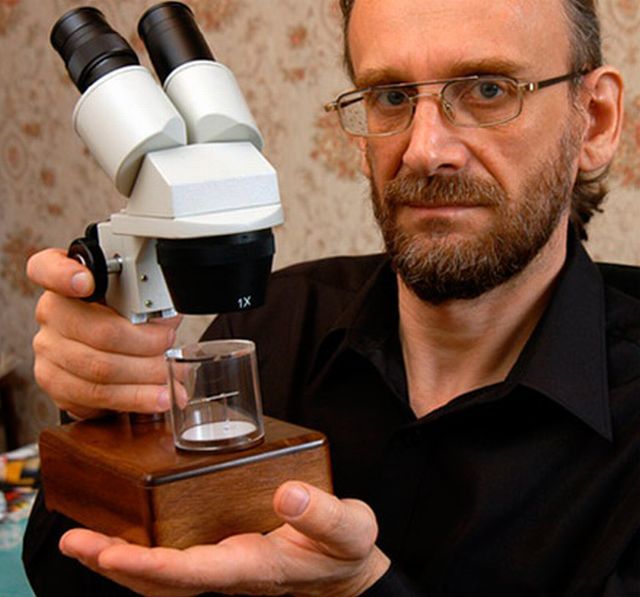

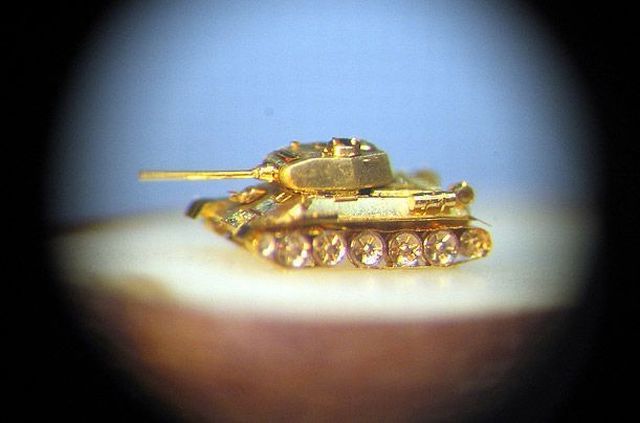




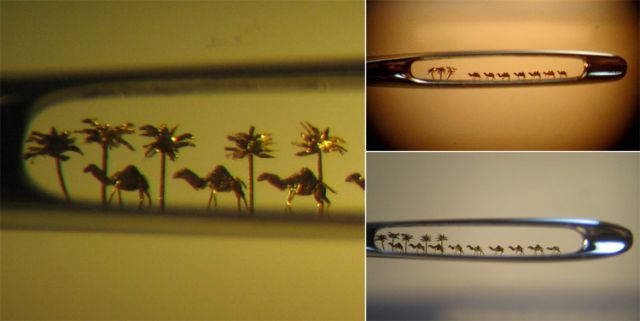





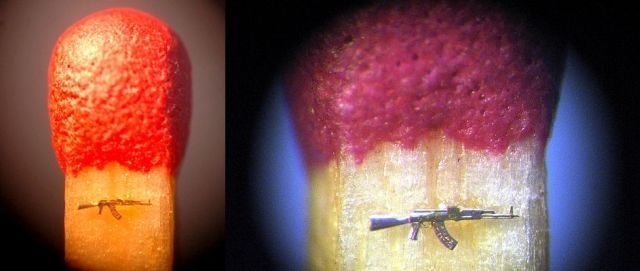
↧












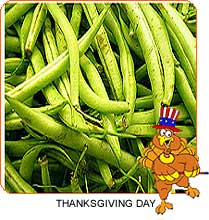





.jpg)












